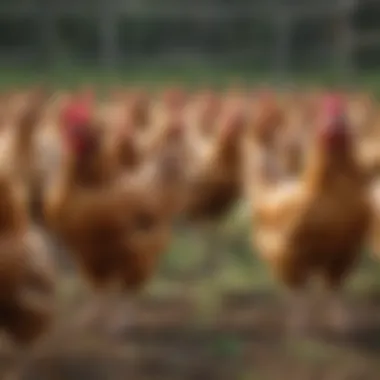Cage-Free Eggs vs Regular Eggs: Key Differences Explained


Intro
Eggs are a common grocery item, yet their labels can be confusing. Two popular types are cage-free eggs and regular eggs, which signify different production practices. This article aims to enlighten readers about these critical distinctions, helping consumers make informed choices regarding their dietary habits.
Understanding these differences is crucial not only for personal preferences but also for ethical, health, and environmental considerations. In this guide, we will analyze production methods, nutritional values, and potential impacts on consumer choices. This information is valuable for families and individuals focused on making educated food selections in their own kitchens.
Production Methods
Cage-free eggs come from hens that are not kept in small cages. Instead, these hens are given access to indoor spaces where they can roam freely. Some farms also provide outdoor access.
Regular eggs, typically referred to as 'conventional', originate from hens that are housed in tightly confined conditions. This industrial agriculture approach limits the birds’ movement and natural behaviors.
Consumer Implications
Purchasing choices regarding cage-free and regular eggs impacts animal welfare, environmental sustainability, and one’s own health. Making informed decisions regarding egg consumption can align with personal dietary principles.
This consideration encourages an evaluation of what one is buying, balancing cost against ethical and health considerations, especially as we confront contemporary food production challenges.
Informed consumers prioritize both health and ethical implications based on their dietary choices.
Nutritional Values
Nutritionally, both cage-free and regular eggs provide proteins, vitamins, and healthy fats. However, debate surrounds potential variations in nutrient density. Studies suggest that cage-free eggs may contain higher omega-3 fatty acids, though the differences can vary by brand and feeding processes.
Cage-free hens might benefit from more natural diets which often results in richer egg yolks. In contrast, the rigorous confinement of hens producing regular eggs sometimes translates into nutritional disadvantages.
Ethical Concerns
Aside from nutrition, ethical shopping involves understanding the welfare concerns associated with egg production. Supporting cage-free farms is often seen as a gesture towards humane animal husbandry, fulfilling consumer responsibility toward animal rights.
The industrial farming practices inherent in most conventional egg production could contradict many consumers' ethical stances, driving the demand towards cage-free options.
Synthesis
The choice between cage-free eggs and regular eggs extends beyond merely selecting a product. It reflects values about health, environment, and ethics. Consumers are advised to reflect on their priorities and conduct thorough research. Educating oneself about egg production practices is essential in the effort to make responsible food choices in today's complex grocery environment.
Prelude to Egg Production
Understanding egg production is essential, not only for food lovers but also for anyone concerned about health and ethics related to their diet. Eggs are a common ingredient in many meals, but the type of egg can vary significantly. Regular eggs, typical from conventional farming methods, are produced under very different conditions compared to cage-free eggs. This distinction impacts nutritional values, flavor, and the overall consumer experience.
A deeper insight into egg production can guide consumers in making choices aligned with their individual values and dietary needs. It is crucial to grasp not just the types of eggs available but what each type implies regarding animal welfare, environmental concerns, and nutrition. This foundational knowledge prepares one to evaluate egg labels and discuss the quality and ethics of egg production.
Overview of Egg Types
There are several categoreies of eggs available on the market today. Understanding these can greatly influence purchase decisions. Some of the primary types include:
- Conventional Eggs: Often produced by hens kept in crowded cages with limited space.
- Cage-Free Eggs: Hens are not kept in cages and can roam in a controlled indoor environment.
- Free-Range Eggs: Hens have outdoor access and a more spacious living arrangement.
- Organic Eggs: Hens are fed organic feed, have outdoor access, and are raised without synthetic pesticides or fertilizers.
Each category tells a story about production practices and animal welfare, influencing not just health aspects but also the ethical sentiment behind the egg on your plate.
Importance of Understanding Egg Labels
Labels on egg cartons are crucial for making informed decisions. They can be misleading or ambiguous, which often fuels confusion among consumers. Here are some key reasons to pay attention to egg labels:
- Nutritional Information: Different egg types can have varied levels of nutrients, such as Omega-3 fatty acids or vitamin D, which might appeal to health-conscious buyers.
- Animal Welfare: Some consumers prioritize ethical considerations in their purchases. Knowing what labels like “cage-free” or “free-range” truly mean can matter immensely.
- Sustainability Practices: Understanding the environmental impact of different farming methods can lead you to make more responsible choices.


In consumption circles, informed choices drive consumer behavior. Thus, recognizing what each term signifies on egg packages allows buyers to align their purchases with their values effectively.
It is vital that consumers challenge themselves to look beyond attractive packaging and delve deeply into what agricultural practices their food sources represent.
Cage-Free Eggs Defined
Cage-free eggs are becoming increasingly popular among health-conscious consumers and those concerned about animal welfare. They are considered a more humane option compared to their conventional counterparts. Understanding cage-free eggs is critical for making informed decisions about egg consumption. These eggs come from hens that are not confined to cages and often have access to larger spaces. However, this does not guarantee that the hens have complete freedom. This section delves deeper into curious specifics, highlighting benefits and necessary considerations related to cage-free eggs, ensuring a comprehensive grasp of what sets them apart.
Regulatory Standards for Cage-Free Eggs
The regulatory framework for cage-free eggs includes various guidelines meant to ensure minimum welfare standards for hens. In the United States, the United Egg Producers' Animal Welfare Guidelines express concerns over the living conditions of egg-laying hens. According to these standards, cage-free hens should have a minimum space allocation that allows them to stand, lie down, and turn around freely.
Regulatory practices can differ significantly between countries. For example, in the European Union, stricter rules mandate outdoor access for chickens in some systems. It’s important for consumers to understand these standards; not all labels that read
Regular Eggs Explained
The section discussing Regular Eggs is crucial for understanding how they differ from cage-free eggs not only in terms of production but also in terms of quality, nutrition, and various consumer considerations. Regular eggs, often labeled as conventional, are commonly found in grocery stores and are frequently the default choice for many consumers. Understanding their characteristics is key for making informed decisions about egg consumption.
Typical Practices in Conventional Egg Production
Conventional egg production practices are designed primarily for high yields and efficiency. This results in eggs being produced in large volumes with limited physical space for the hens. Typically, hens are kept in battery cages. These cages can house numerous birds in a confined area, minimizing housing costs while maximizing output. Such practices serve to keep prices relatively low, but come at a cost similar to limited hen freedom and potential welfare concerns.
The process starts early, as hens are bred specifically for egg-laying. They are often fed a commercial feed that supports mass production of the eggs. The animals route through an intense cycle, laying eggs nearly daily.
A few key characteristics of conventional egg production practices include:
- Use of battery cages, often keeping hens in cramped quarters.
- Reliance on avian growth promotants to maximize egg yield.
- Automated systems for feeding and egg collection.
- Cost-efficient measures that lead to reduced price but raised ethical questions about treatment of hens.
Living Conditions of Regular Hens
The living conditions for hens raised for regular eggs vary considerably from those of cage-free layers. Traditionally, these chickens are kept in densely populated environments, limiting their mobility and natural behaviors. Because of their living arrangements, hens cannot engage in instincts such as nesting or having adequate space for movement.
In a confined battery cage system, each hen has less living space than an A4 sheet of paper. This minimal allowance can lead to significant stress affecting overall egg quality. Hen wellbeing comes into scrutiny based on these established living conditions. Important aspects concerning their environment include:
- Cramped quarters, which can lead to aggressive behavior such as pecking.
- Limited access to natural light, affecting their circadian rhythms.
- Restricted abilities to move freely, which may impact their overall health.
Given the rise in consumer awareness of welfare issues, there is ongoing scrutiny on how these practices affect not just the hens’ health but the quality of the eggs they produce. Ultimately, following best practices while there is a quick economic benefit might command a higher price but ensures welfare standards and better product integrity.
The public's understanding of egg production conditions is growing, with more people acknowledging the consequences of conventional techniques on both poultry welfare and the eggs consumers choose to eat.
Nutritional Comparison of Cage-Free and Regular Eggs
Understanding the nutritional differences between cage-free and regular eggs is essential for consumers who prioritize their health and culinary choices. This section delves into specific components that contribute to these distinctions, particularly focusing on macronutrients and micronutrients. With rising awareness of dietary implications, the choice between these egg types has important consequences beyond flavor or texture.
Macronutrients Profile
When comparing cage-free eggs to their conventional counterparts, macronutrient levels typically show some variances. While both contain substantial amounts of protein, the content of unsaturated fats can vary. Cage-free eggs often come from hens that forage for themselves, which may enhance the nutritional profile. A few key points to consider include:
- Protein: Both types provide around 6 grams of protein per large egg, crucial for repairing tissues and muscle growth.
- Fat content: Cage-free eggs may have higher levels of omega-3 fatty acids when hens are fed enriched diets, possibly leading to health benefits like improved heart health.
- Calories: Regular eggs typicaly fall into a slightly lower calorie category, averaging about 70 calories each, while cage-free eggs can reach up to 80 calories on average.
This profile overall suggests that while the base nutrients are similarly beneficial, the rich sourcing of cage-free eggs could amplify certain positive aspects that aid in daily health.
Vitamins and Minerals
Furthermore, the vitamin and mineral content varies between cage-free and regular eggs, which may influence consumer decisions. The hens’ diets also play a significant role here. Several nutritional differences include:
- Vitamin D: Cage-free eggs are often higher in vitamin D, depending on their exposure to sunlight and diet enriched with vitamin D-rich feed.
- Vitamin E: There is rising evidence to suggest that cage-free eggs can be replete with vitamin E, supporting immune health and skin well-being due to their varied foraging practices.
- Minerals: Studies indicate a notable increase in omega-3s and a better ratio of beneficial minerals like selenium and zinc in cage-free eggs.


In summary, understanding macronutrient and micronutrient differences could guide informed choices based on specific health needs or dietary preferences.
Influencing these details is the historical data on egg production. Insight into these key nutritional differences helps clarify why consumers might select one type over the other, particularly health-conscious consumers or those mindful of their dietary intake.
Taste and Cooking Differences
Understanding how cage-free and regular eggs differ in taste and cooking methods is crucial for consumers aiming to enhance their culinary experience. The choice affects not just the outcome of dishes but also the enjoyment associated with using these ingredients. Although often overshadowed by health and ethical aspects, taste and cooking distinctions can significantly influence personal preferences and cooking results.
Flavor Profiles: Cage-Free vs.
Regular
The flavor profiles of cage-free and regular eggs can vary drastically due to the differences in their diets and living conditions. Cage-free hens generally have access to more natural diets which can include a wider variety of grains, grass, and perhaps even insects. This diverse diet often translates to eggs that possess richer flavors,
Cage-free eggs may present a creamier texture and deeper yellow yolk, characteristics that many culinary enthusiasts appreciate. In contrast, regular eggs, often derived from predominantly grain-fed hens housed in traditional cages, tend to yield a more neutral taste. Because of their diet limitations, these eggs may lack the pronounced richness often soughtafter in gourmet cooking.
Consumers have reported that when cooking, cage-free eggs tend to hold up better in certain dishes, adding more to the overall flavor complexity.
Cooking Techniques and Results
When approaching cooking with both egg types, there are several considerations to keep in mind. Cage-free eggs typically respond well to various cooking methods, retaining their shape and moisture.
- Scrambling: Cage-free eggs fluff up nicely and provide a denser, creamier result with a more pronounced flavor. These qualities can elevate standard dishes such as scrambled eggs or omelets.
- Frying: When fried, cage-free yolks often exhibit a richer hue and a more decadent flavor. A sunny-side-up egg becomes a fine culinary moment with gown higher the color ambitions.
- Baking: In baking, cage-free eggs enhance textures in cakes and cookies, often making them cakewives luscious.
In contrast, regular eggs can also be effective across similar cooking techniques but may lead to outcomes that lack depth in flavor. They may not provide the same smoothness or consistency as their cage-free counterparts.
Important Note: Many chefs believe that using cage-free eggs can significantly impact the overall taste of a dish, thus making them a viable choice for anyone serious about gastronomy.
In summary, while both cage-free and regular eggs serve as valuable kitchen staples, the flavor and cooking experiences can diverge noticeably, catering to varied preferences and culinary ambitions.
Ethical Considerations in Egg Production
Understanding ethical considerations in egg production is vitally important for both consumers and producers. The fast-paced environment faced by today's buyers demands clarity on what constitutes responsible practices concerning poultry farming. As individuals increasingly turn to sustainable options, the implications of egg sourcing directly impact choices at the grocery store. Ethical farming promotes a culture of respect towards animals and the environment, contributing to higher welfare standards and sustained practices.
Animal Welfare Issues
Animal welfare is at the core of the ethical debate surrounding egg production. Cage-free hens, for example, typically enjoy more freedom to roam in larger spaces, laying an important step toward improved living conditions compared to their caged counterparts. Despite this, various standards still exist to clearly define what cage-free means. According to specific guidelines, these hens should have a minimum amount of space per bird. This results in reduced stress and the ability to engage in natural behaviors such as socializing, nesting, and dust-bathing.
Yet, even within cage-free systems, herding practices can vary. A close evaluation of a given farm's practices reveals deeper insights into how ethical considerations position animal welfare as both a practice and a selection variable for radios in the market. Comprehensive animal well-being ensures healthier hens and, by extension, high-quality eggs. Thus, producers and consumers must both advocate for more transparent conditions that prioritize animal welfare in the egg farming industry.
Consumer Responsibility
With growing interest in ethical sourcing, consumers hold a unique responsibility when it comes to purchasing eggs. Understanding the implications behind choices made can instigate a shift towards systems advocating ethical integrity. This responsibility extends beyond purchasing decisions; it includes being informed about the specific conditions under which eggs are produced. Insight into a product's journey before reaching the supermarket shelf helps in recognizing and supporting responsible practices.
"By choosing cage-free or better yet organic options, consumers can significantly impact the market demand for humane eggs."
Another component of consumer responsibility is voicing support for brands or farms that adhere to higher welfare standards. Making decisions based on credible information, including certifications such as Certified Humane or Animal Welfare Approved, and engaging with local agriculture initiatives further strengthens this responsibility. Not only does informed consumption promote higher welfare practices, it likewise incentivizes producers to adopt and promote more sustainable and responsible systems aimed at ensuring ethical practices throughout the supply chain. Consumers ultimately shape consumer behavior and nurture the emerging demand for ethical farming methods, impacting overall egg production positively.
Environmental Impact of Egg Production
The environmental impact of egg production plays a significant role in understanding the full implications of our dietary choices. The production methods inherently involve various resource use including land, water, and energy. The way eggs are produced affects not just the hens themselves, but the wider ecosystem. Understanding this aspect enlightens consumers on the different ramifications of cage-free versus regular eggs.
Sustainability in Cage-Free Farming
Cage-free farming emphasizes better animal welfare practices, but it also touches on environmental sustainability. In systems that allow hens to roam indoors, there may be an increase in resource efficiency. These systems can lead to less carbon dioxide emissions and might utilize less land compared to traditional methods. Moreover, local farms often support sustainable practices by utilizing natural inputs, creating local economies tied to the farming of cage-free eggs.


In a cage-free environment, the potential for more humane treatment often goes hand-in-hand with environmentally conscious practices. For example:
- Less Intensive Resource Use: Since cage-free farming often does not concentrate a large number of hens in one building, the requirement for feeding and cleaning can be less intensive overall.
- Biodiversity Promotion: These farms may integrate crop farming alongside egg production, aiding in biodiversity. The use of natural pest control mechanisms arises due to encounters between poultry and local ecosystems, leading to positive outcomes.
Footprint of Conventional Eggs
Conversely, conventional egg production is marked by high-density farming practices, which tend to have a more significant negative environmental impact. Often referred to as battery farming, this method groups a high number of hens in cramped conditions, which also drives up resource use disproportionally. The following concerns illustrate the environmental costs:
- Higher Greenhouse Gas Emissions: The significant energy use in heating, cooling, and ventilation often leads to larger carbon footprints than their cage-free counterparts.
- Land Degradation: The production cycle dictates a demanding process for land preciousness. Continuous use diminishes soil quality and interrupts natural ecosystems.
- Water Usage: High population density increases strain on local water supplies. Global variables might exacerbate these issues, especially in regions already vulnerable to droughts.
"Making better dietary choices can have lasting impact not just on our health, but on the environment as well."
Economic Aspects of Cage-Free vs.
Regular Eggs
The economic implications of choosing cage-free eggs over regular eggs are essential to understanding the broader landscape of egg production and consumption. The relationship between price differentiation, market demand, and trends influences consumer choices significantly. For many, the monetary aspect cannot be overlooked. These economic factors often correspond to values related to ethics and nutrition, impacting purchasing decisions in a nuanced manner.
Price Differences
Price variations present one of the most visible distinctions between cage-free and regular eggs. Cage-free eggs can command prices that are typically higher than their conventional counterparts, a reflection of the differing production costs involved. This increase in price results from several factors:
- Higher Operational Costs: Cage-free systems require more space per hen, leading to increased expenses for feed, housing, and the maintenance of facilities.
- Lower Production Rates: Cage-free hens may lay fewer eggs than those kept in traditional cages due to stress factors or differing farm management techniques.
- Certification Costs: Ensuring compliance with cage-free standards typically involves additional inspections and certifications, which contribute to higher prices.
This is significant for consumers who seek to align their purchasing behavior with personal beliefs about animal welfare or health consciousness, often forcing a rethink about spending habits. In contrast, regular eggs are more amply produced, benefiting from less stringent regulations, and thus usually appear more economical at checkout.
Market Demand and Trends
Consumer preferences signify evolving attitudes toward egg consumption. In recent years, the demand for cage-free eggs has illustrated a pivotal shift in market dynamics:
- Increased Demand: A growing awareness of animal rights and health has driven more buyers towards cage-free options. Retailers report a notable rise in sales for cage-free products, often at the expense of regular eggs.
- Retail Response: Many grocery stores and food brands now offer ample selections of cage-free products. This is not merely a response to consumer demand; it is a retention strategy, aimed at enhancing brand loyalty among ethically motivated consumers.
- Consumer Demographics: Younger generations, notably Millennials and Gen Z, show more inclination toward supporting sustainable practices. They prioritize transparency around food sourcing, encapsulating broader dining trends promoting welfare-oriented products.
The economic factors governing the cage-free and regular egg industry drive a complex interplay of ethics, health, and consumer demands.
Through understanding these challenges into the economic discussions, we capture the essence of informed decision-making around egg purchases. Addressing these aspects gives consumers a holistic account when considering their priorities, making it paramount to recognize how market trends shaped their dietary preferences.
Culmination and Recommendations
Making an informed choice involves examining several factors:
- Nutritional Benefits: Consider the nutritional variances between cage-free and regular eggs. Cage-free eggs may present higher omega-3 fatty acids, which are beneficial for overall health.
- Ethical Considerations: Being informed also means taking into account animal welfare. Cage-free farming offers a life with more space and natural conditions for hens compared to conventional practices.
- Environmental Footprint: Knowing the environmental impact is essential. Cage-free operations may encourage more sustainable farming methods, leading to a lesser ecological footprint.
- Price Awareness: Acknowledging price differences between these two types helps consumers budget accordingly. Cage-free eggs often cost more, reflecting the better living standard for hens.
With these considerations in mind, individuals can tailor their purchases to align with their values and nutritional needs. The brewing consumer awareness of the impact of their purchases will hopefully steer the market positively.
Making Informed Choices
Making informed choices about egg selection requires careful consideration of the labels and certifications found on packaging. The presence of certain seal certifications can clue buyers into the breeding and living conditions of the hens. Such certifications include the American Humane Certified seal and Certified Humane Free Range label. These designations give confidence that ethical practices have been observed in the production of eggs.
Moreover, researching and staying up-to-date on farming practices helps consumers remain vigilant. Engaging with community discussions around egg production can aid in driving awareness.
Keep in mind the values that dictate your choices - health implications, animal rights, environmental sustainability, or allergies. Align your purchases with these principles to assure satisfaction and confidence in the choices made.
Future Trends in Egg Production
The future of egg production is evolving steadily as more consumers motivate farms to implement innovative practices. More farms are moving towards integrated portfolio strategies, blending cage-free and free-range systems. Such adaptations seem promising to balance cost and consumer expectations.
Environmental sustainability is becoming a core focus, with many producers aiming for reduced carbon footprints. They explore alternative feeds and regenerative farming practices that nurture soil health, which could further enrich the poultry ecosystem.
Some micro-level trends visible in egg production include:
- Automation in Farming: Use of technology to enhance efficiency: robotic systems can assist in monitoring hen welfare, reducing labor while increasing care standards.
- Local Sourcing: Many consumers express a preference for locally sourced products, leading to an uptick in farm-to-table operations.
- Innovative Marketing: Brands today use transparency about their production processes to win consumer trust. This trend will likely escalate in future marketing efforts.
By keeping an eye on these trends, consumers can impact the market through their purchasing choices, steering demand towards healthier, sustainable practices. Engaging thoughtfully with the evolving aspect of egg production can prove beneficial for personal well-being and the wider community.







